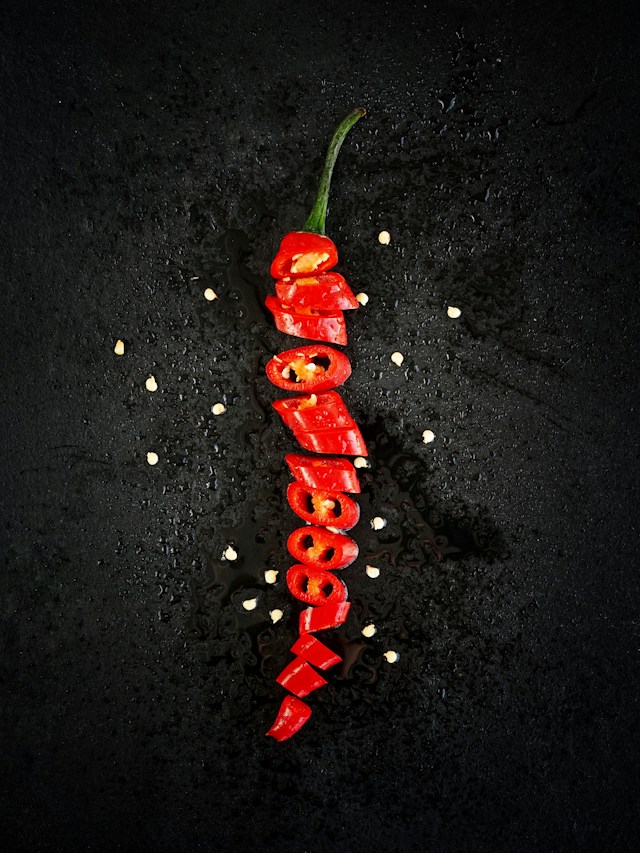How to master the art of cooking with spicy peppers?

Peppers are an intrinsic part of global cuisine. From the fiery heat of a Mexican jalapeno to the smoky undertones of a Spanish piquillo, peppers have a way of adding depth and complexity to dishes. Cooking with peppers, specifically spicy ones, is an art that requires balance and nuance to achieve the perfect blend of heat and flavor. Indeed, the secret to mastering the art of cooking with spicy peppers lies in understanding their heat levels, the ways they can be incorporated into sauces and dishes, and how to balance their heat with other ingredients.
Understanding Heat Levels in Peppers
Before diving into the world of spicy peppers, it’s important to understand the concept of heat levels. The heat in peppers comes from a chemical compound called capsaicin. The amount of capsaicin present in a pepper will determine its heat level, measured using the Scoville Heat Units (SHU).
A découvrir également : How do you create a deliciously healthy acai bowl?
Peppers range from mild bell peppers with zero SHU to the dangerously hot Carolina Reaper, clocking in at over 2 million SHU. When adding spicy peppers to dishes, remember to take into account their heat level. The heat of the dish can be adjusted by controlling the quantity and type of pepper used.
Tip: Always handle spicy peppers with care. They can cause skin irritation. Wash your hands thoroughly after handling them and avoid touching your face.
A lire également : How to make a classic french ratatouille?
Incorporating Peppers into Sauces
One of the most common ways to add heat to a dish is by incorporating peppers into sauces. Spicy sauces can add a kick to any dish and are particularly useful for flavoring meats, vegetables, and grains.
To make a basic hot sauce, you’ll need fresh peppers, vinegar, salt, and additional flavoring ingredients like garlic, onion, or spices. Chop the peppers and combine them with the other ingredients in a saucepan. Simmer the mixture until the peppers are soft, then blend until smooth. Strain the mixture to remove any seeds or skins, then return to the heat to cook down to your desired thickness.
Remember: The vinegar and salt not only add flavor but also act as preservatives, helping your hot sauce last longer.
Adding Heat to Dishes
Adding peppers to your dishes is a surefire way to spice things up. Whether you’re cooking a stir-fry, soup, or casserole, peppers will add heat and depth of flavor.
When cooking with fresh peppers, it’s best to add them in stages. This will allow the heat and flavor to build gradually. Start by sautéing diced peppers in oil to release their flavors. Then add the rest of your ingredients and continue cooking.
For dried peppers, they need to be rehydrated before adding to your dish. Soak them in warm water for about 20 minutes until they become pliable. Then, they can be chopped and added to your dish.
Note: With both fresh and dried peppers, you can control the heat level by adjusting the amount of seeds and ribs you include. The more seeds and ribs, the hotter the dish will be.
Balancing Heat with Other Ingredients
While the heat from peppers can be exciting, it’s important to balance it with other flavors to prevent your dish from becoming overwhelmingly spicy. There are several ingredients that can help mitigate the heat.
Dairy products are often used to tame the heat from peppers. The fat in dairy helps neutralize the capsaicin, providing a cooling effect. Consider adding cheese, cream, or yogurt to your spicy dishes.
Acidic ingredients like vinegar, lime, or tomatoes can also help balance the heat. They cut through the spiciness, adding a brightness that complements the heat.
Finally, sweet ingredients can counteract the heat by offering a contrasting flavor. Honey, sugar, or fruits can be added to dishes to balance the spiciness.
Experimenting with Different Pepper Varieties
Mastering the art of cooking with spicy peppers involves experimenting with different varieties. Each type of pepper has a unique flavor profile and heat level, offering endless possibilities for your dishes.
For starters, jalapenos are a great addition to salsa, guacamole, or tacos. They have a moderate heat level and a fresh, crisp flavor. Habaneros, on the other hand, are much hotter and have a fruity, citrusy flavor. They work well in Caribbean and Mexican dishes.
If you’re looking for something less spicy, consider using Anaheim or poblano peppers. They have a mild heat and a sweet, earthy flavor, making them perfect for stuffing or adding to soups and stews.
By understanding and experimenting with different types of peppers, you’ll be well on your way to mastering the art of cooking with spicy peppers.
The Fundamentals of Cooking with Spicy Peppers
Having covered heat levels, ways to incorporate peppers into sauces and dishes, and balancing their heat with other ingredients, the next step in mastering the art of cooking with spicy peppers is understanding their proper handling and preparation.
Lets take a closer look at the essentials. First up, seeds membranes. The heat in a pepper is concentrated in the seeds and the white membranes, so removing these parts would give you a milder flavor. If you want to turn up the heat, include them in your cooking.
When creating a hot sauce, start with a base of cayenne peppers, serrano peppers, or jalapenos. Then, depending on your personal heat tolerance and taste preference, you can experiment with hotter varieties like the ghost pepper or Carolina Reaper. With their intense heat, these should be used sparingly and with caution.
It’s also worth noting that dried chilies have a different flavor profile than fresh ones. Dried chilies have a rich, smoky flavor that adds depth to dishes. They are excellent for making hot sauces or salsa, and they can also be rehydrated and used like fresh peppers.
Lastly, when cooking with chili peppers, always remember to taste as you go. Adding too much at once can result in a dish that’s too hot to eat, so it’s best to start with a small amount and add more until it’s at your desired heat level. And remember, you’re cooking for your taste buds. If the heat is too intense, use some of the balancing ingredients mentioned previously.
Conclusion: Mastering the Art of Spicy Food
Mastering the art of cooking with spicy peppers is not only about understanding heat levels or knowing how to make a hot sauce. It is also about recognizing the unique characteristics of each type of pepper, whether it’s a fresh chili or a dried one, a mild Anaheim or a fiery ghost pepper.
You have to appreciate the complexity and the depth that peppers with different heat levels bring to a dish. Remember, it’s not just about the heat, but also the flavor. So don’t be afraid to experiment with different types of hot peppers and find the ones that appeal to your palate the most.
Don’t forget, the "heat" in a dish is not meant to overpower, but to enhance and balance other flavors. Whether it’s the creaminess of cheese, the acidity of tomatoes, or the sweetness of honey, the key is finding that perfect balance where the heat from the pepper complements the other flavors.
Ultimately, cooking with spicy peppers is a journey. It’s an exploration of flavors and heat levels, a constant learning experience that challenges your taste buds. So embrace the heat, enjoy the journey, and before you know it, you’ll have mastered the art of cooking with spicy peppers.
